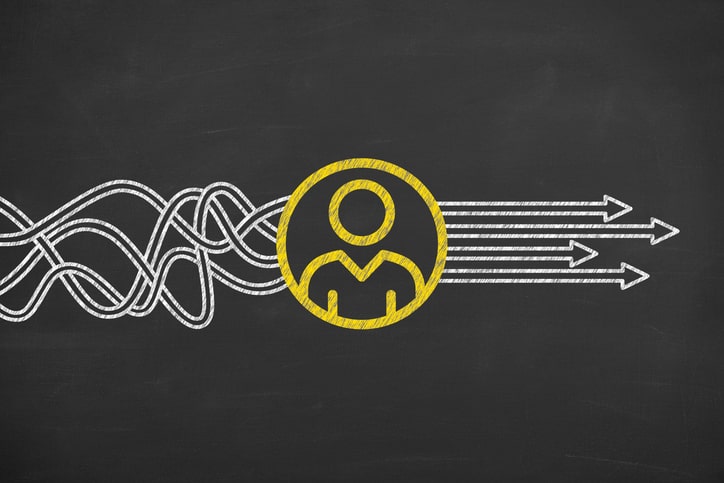Your system is dynamic and responsive to what is happening in and around you. As a result, what you’re thinking and how you’re feeling is constantly changing. Because of this, you may not always be able to access your highest expression and present yourself in alignment with your personal brand.
Furthermore, your mind and body are interconnected, which impacts how you think and feel. As a result, your ability to show up and interact with others ebbs and flows, requiring ongoing attention to what’s working well and what’s not. The more you do so, the more you’ll be able to catch yourself and make tweaks in your behavior instead of falling victim to your instinctual patterns.
Take ownership of your personal brand.
Living true to your brand means your internal system, desires, values, and goals are in harmony with your outward persona and actions. As the ultimate owner of who you are and want to be, you can determine when it’s time to pause and do a reboot.
Embracing self-care rituals and spending time communicating internally can help you remain level-headed and objective, and minimize external factors that can negatively impact you. Additionally, establishing a daily intention and reflection practice can help you stay focused on your priorities.
For example, as you begin your day, you can answer questions like, “How do I want to feel?, How do I want to spend my time?, What would inspire me into action?” Then, when you close out your day, you can reflect on, “What worked well? What didn’t? How do I want to adjust for tomorrow?”
Reconnect with your strengths and expertise to self-regulate.
Whenever you sense “I just don’t feel like myself,” your inner state is out of alignment with your outer experience. When this occurs, it’s your signal to stop whatever you’re doing, assess the situation, and determine what you need to reset and restore your equilibrium.
For instance, it may just be hunger, the desire to move, or the lack of rest knocking you off your game. Alternatively, you could be “in the grip” of your inferior function, the hidden part of your personality and a defining element of Carl Jung’s typology, that emerges most dramatically during times of stress, fatigue, and illness.
Other times, outside forces may have impacted your ability to think rationally, where you may have forgotten your strengths and how competent and resilient you are. These hurdles can be meaningful learnings that provide insight into your system’s requirements to feel grounded and boost your self-confidence.
Here are five ways to reset when you can’t show up as you like and to harness your YOU-ness:
#1 Remind yourself of your purpose.
Some of the most beneficial outcomes of inner work are reconnecting with your inner knowing and shifting your mindset to cultivate new habits that support your mission and remind you of your distinct magnificence and strengths. Additionally, learning to accept all aspects of yourself can help you minimize the need to cover up and blend into mainstream expectations. By discerning between your thoughts and what others may have impressed upon you, you can gain awareness of unanswered questions, process your thoughts and emotions to work through difficult decisions, and problem-solve. As your confidence in your capabilities grows, other people’s opinions will impact you less, making you less attached to your established personas.
#2 Embrace betterment, not perfection.
When you’re not at your best, give yourself some grace and practice self-compassion, treating yourself as you would a good friend. Additionally, assessing your current state and desired state can help you decide on some simple steps you can take to close the gap. For example, think about a time when you showed up as you wanted and evaluate what made you successful, noting which skills, expertise, and experience enabled you to do so. And if you can’t remember, reach out to a trusted friend or colleague to help you do so. On the flip side, if you’re feeling off-kilter due to inaction, don’t forget that contentment and being happy with the status quo can be good things that offer you time and space to strategize on ways to continue to grow and flourish.
#3 Identify what lights you and what drains you.
Because your internal system is easily impacted when you’re in relationships with others, it’s unrealistic to maintain a high-vibe or peaceful state at all times. However, the more alert you are about your present state, the more you can identify what may be missing. Additionally, uncovering your Sparketype® can help you pinpoint what energizes you and what depletes you. When your thoughts and actions are aligned with what motivates you, you can reduce any confusion or friction between your heart and mind to experience more joy and fulfillment. Author Mihaly Csikszentmihalyi called this state “flow,” when your actions and awareness are merged as one, and you can fully concentrate on a task with effortlessness and ease.
#4 Access your Human Design blueprint.
Your Human Design showcases how your energy flows through your system and offers insights to live in an empowering and fulfilling way. Understanding which of your centers (aka Chakras) are defined and have reliable momentum, as well as knowing which are undefined and influenced by others and your environment, can help you process your emotions to help avoid burnout. Additionally, it can indicate ways to remain loyal to yourself by creating boundaries and prioritizing self-care. Furthermore, your Human Design provides information about inherent “conundrums” that can impact and influence your self-concept, where you may feel stuck, confused, scared, or act in self-sabotaging ways. Once you are aware of these challenges, you can work on minimizing or eliminating the patterns and subtexts that form in response, e.g., inner critics, susceptibility to outside influences, and resistance to change.
#5 Revisit learnings or invest in new ones to shift perspective.
A common theme of “high and low expressions” runs through most skills’ development, personality, psychological, and behavioral assessments, as well as therapeutic modalities. The names may be different, such as the Enneagram’s “Stages of Development” or “Integration Levels,” the Myers-Briggs® Type Indicator’s (MBTI) “Dichotomies,” the Emotional Intelligence’s (EQ-i 2.0®) “Leadership Scale,” and Internal Family Systems (IFS), “Polarizations.” However, the ranges within these systems reflect similar aspects—healthy to unhealthy behaviors—regarding how we view and interact with ourselves and other people, handle stress, and deal with various situations. If you have already worked with one of these techniques, revisit your report to garner a new perspective. Further, you can expand your interpretation of things through “What if?” questioning and visioning.
Your attitude and belief in yourself make all the difference.
As you become more self-aware, you can incorporate ways to modify what no longer serves you—thus embracing your best self—who you are at the core level. Here are ten practices that have enriched my well-being and outlook on life. Also, you don’t need to wait until a particular date or milestone to begin. Take one step—now—no matter how small, while you’re determined to alter your state of being.
Activate your best with those around you.
Self-leadership is about getting to know yourself better and applying that knowledge to how you interact with others. As a lifelong student, certified professional coach, and consultant, activating the best in others through self-leadership, interpersonal relations, and team dynamics are passions of mine. My approach is personalized and customized, tapping into various assessments, disciplines, modalities, and techniques. Also, check out my “Micro & Mini Service Offerings” and try one session to inspire you. Sign up solo or with another person or group to work on a specific exercise or activity and split the costs! Contact me to get started.

